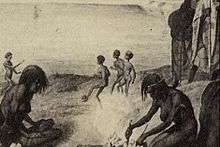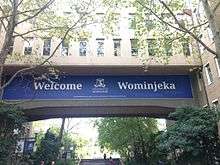Woiwurrung language
| Woiwurrung | |
|---|---|
| Region | Victoria |
| Ethnicity | Wurundjeri |
| Extinct | (date missing) |
| Language codes | |
| ISO 639-3 |
wyi |
| Glottolog |
woiw1237[2] |
| AIATSIS[3] |
S36 |
|
The five Kulin nations. Woiwurrung is in yellow. | |


Woiwurrung (sometimes spelt Woiwurrong, Woiworung, Wuywurung) is an Indigenous Australian language spoken by the Wurundjeri people of the Kulin Nation of Central Victoria, from Mount Baw Baw in the east to Mount Macedon, Sunbury and Gisborne in the west. The language remains, but is not widely known or spoken due to the impact of colonisation.
The Woiwurrung clans inhabited the Yarra River, called Birrarung in Woiwurrung, before European displacement. Each tribe has its own distinct territory and boundary usually determined by waterways. The clans include:
- The Wurrundjeri-Willam, who occupied the Yarra River and its tributaries and inhabited the area now covered by the city of Melbourne. Referred to initially by Europeans as the Yarra tribe.
- The Marin-Bulluk
- The Kurung Jang Balluk
- The Wurundjeri Balluk
- The Balluk Willam
- The Gunung Willam Balluk
- The Talling Willam
Although not all Woiwurrung descendants and Woiwurrung speakers are descendents of the Wurundjeri people, Wurundjeri has become one of the common terms used today for descendants of all the Woiwurrung tribes, as they were forced together for the survival of their ethnic group. Their totems are Bunjil the eagle and Waa the crow.
The Jindyworobak Movement claimed to have taken their name from a Woiwurrung phrase jindi worobak meaning to annex or join.
Consonants
| Peripheral | Laminal | Apical | ||||
|---|---|---|---|---|---|---|
| Bilabial | Velar | Palatal | Dental | Alveolar | Retroflex | |
| Plosive | b/p | ɡ/k | ɟ/c | d̪/t̪ | d/t | ɖ/ʈ |
| Nasal | m | ŋ | ɲ | n̪ | n | ɳ |
| Lateral | l | ɭ | ||||
| Rhotic | r | ɽ | ||||
| Glide | w | j | ||||
It is not clear if the two rhotics are trill and flap, or tap and approximant.
Pronouns
In the case of the Woiwurrung pronouns, the stem seems to be the standard ngali (you and I), but the front was suffixed to wa-, so wa+ngal combines to form wangal below.
| Singular | dual | plural | |
|---|---|---|---|
| 1st person inclusive | wa.ŋal | wa.ŋa.ɲin | |
| 1st person exclusive | wan | wa.ŋan | wa.ŋa.ɲi.ɲu |
| 2nd person | war | wa.bul | wat ɡu.ra.bil(.la), wat ba.lak, wat wu.ɾun.ðu |
| 3rd person | mu.ɲi | mu.ɲi ɡa.ra.bil | ma.lu ɡu.ra.bi.la |
Translation of the words
- Wangal = you and I
- Wangan = we two
- Munyi gurrabil = they two
- Munyi gurrabila = they
Other vocabulary
- Bik = land, country
- Boorondara = shade, darkness, night (origin of the name of the City of Boroondara)
- Nyilum bik = poor soil / hard land (origin of the name of Nillumbik Shire)
- Wominjeka = hello / welcome
- yabber = to talk
- Yarra = flowing, (also means "hair"). Is thought to have mistakenly given to the Yarra River (which was actually called Birrarung by the local indigenous peoples) by an early settler who asked a boy what it was called, who was confused and answered "it is flowing".
See also
References
- ↑ R. M. W. Dixon, Australian Languages: Their Nature and Development: v. 1 (Cambridge Language Surveys). Cambridge University Press, 2002. ISBN 978-0-521-47378-1
- ↑ Hammarström, Harald; Forkel, Robert; Haspelmath, Martin; Bank, Sebastian, eds. (2016). "Woiwurrung". Glottolog 2.7. Jena: Max Planck Institute for the Science of Human History.
- ↑ Woiwurrung at the Australian Indigenous Languages Database, Australian Institute of Aboriginal and Torres Strait Islander Studies
- Barry J. Blake. 1991 Woiwurrung In: The Aboriginal Language of Melbourne and Other Sketches, ed. R. M. W. Dixon and Barry J. Blake, pp. 31–124, OUP, Handbook of Australian Languages 4.
External links
| Look up Woiwurrung in Wiktionary, the free dictionary. |